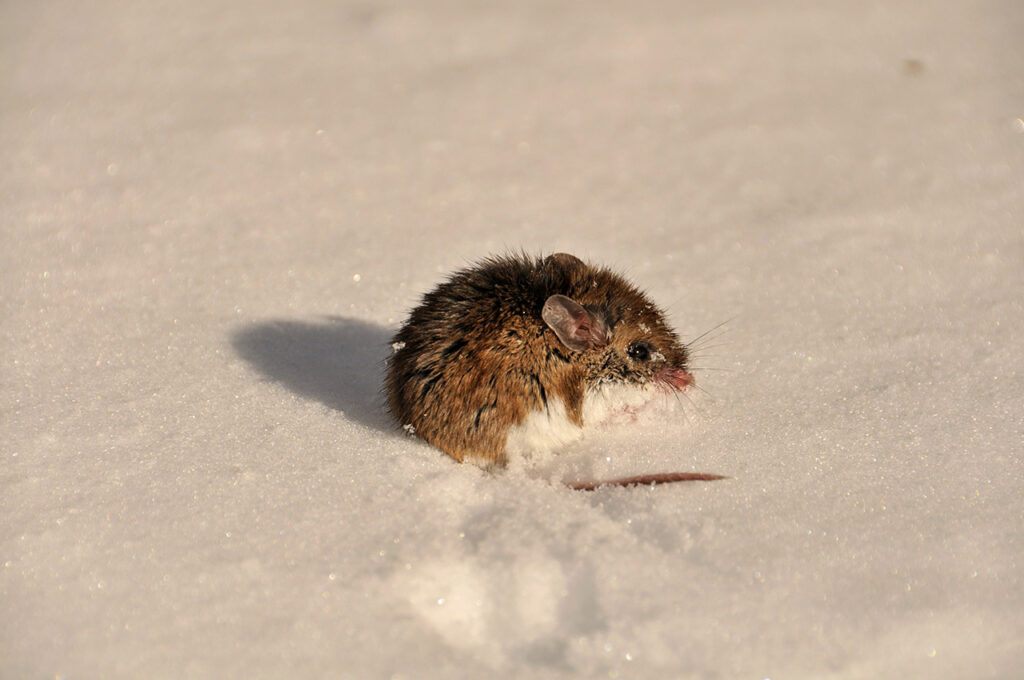White-Footed Mouse Facts
White-footed mice are found in most parts of North America, especially the East coast, southern Mexico, and Canada. White-footed mice, like deer mice, come from the Peromyscus family, which includes many other small mice species, all of which typically have white feet and white undersides. The white-footed mouse is very closely related to its cousin, the common house mouse.

White-footed mice are great swimmers and climbers. They have great balance, thanks to their tails. White-footed mice usually live by themselves unless they are breeding. Mating season depends on where they live, but can range from spring to late summer and even year-round in some southern states. Each litter typically consists of three to five mice. Their young are born blind, but once nursed for three weeks or so, they will leave the nest with full sight, able to fend for themselves.
White-footed mice are generally nocturnal, as they prefer to stay under the radar of predators; it’s possible to see them during the day in search of food. A distinct behavior of the white-footed mouse is the act of “drumming” on leaves or hollow reeds with their front paws. In the fall these little rodents will collect seeds and nuts for their food supply come winter. They love nuts, berries, some small insects, grains, and even fungi. In the wild, they usually live for a year, but in captivity they can live for several years.
White-Footed Mouse Infestation
Like all other mice, white-footed mice pose health risks that can affect you without you even knowing it. For one, white-footed mice play a key role in the transmission of Lyme disease They carry bacteria that causes the disease and can transmit it to ticks. Ticks will then pass the disease along to other mammals, including humans.
In your home, white-footed mouse droppings are what you need to keep an eye out for. Their feces can contain the Hantavirus, which can become airborne when stirred up. The greater the infestation, the greater chance of any pathogens entering the air. You may hear squeaking or scampering in your walls, ceiling, or basement. Droppings can be found in your kitchen cabinets, food-storage areas, or around your sink.
White-Footed Mouse Damage
When in your home, white-footed mice can damage areas of your home as they search of a good nesting spot. They’ll gnaw away at insulation, siding, woodwork, food packaging, or furniture. In some cases, they can chew on electrical wires that can lead to fires. Outside in your garden, their love for seeds can sometimes ruin the growth of new crops as they dig up them for food.
Types of White-Footed Mice
White-Footed Mouse Identification
It can be difficult to tell a white-footed mouse from other species of mice, but luckily, as their name suggests, they have white feet. In addition, white-footed mice also have a reddish brown fur up top and white bellies. When it comes to other types of mice, you can usually tell a white-footed mouse apart by its bi-colored tail. They range in size from five to eight inches including the tail. White-footed mice are also known for their distinctly large ears, which look even larger when compared to their tiny bodies.
White-Footed Mice in the Walls & Home
Your home is like a tree stump to them — they don’t know the difference. White-footed mice nest in hollow trees, brush piles, buildings, and old squirrel or bird nests. You may find activity up in your attic or down below in the basement. Look for nesting materials like grass, leaves, hair, bark, moss, or even cloth. The greater the infestation, the more droppings you’ll notice around your home. Like most other species of mice, white-footed mice travel the same routes every day.
Frequently Asked Questions
What do white-footed mouse droppings look like?
Their droppings are very tiny, usually around 1/8 of an inch in length. Normally, the droppings resemble rice or grains in shape. White-footed mouse droppings are much closer in size to, say, a cockroach than some larger breeds of rodent like the roof rat or the Norway rat.
What are the benefits of professional white-footed mouse pest control?
Finding and removing any type of mouse infestation can be challenging, especially if there are numerous nesting sites in the attic, basement, or walls of a business or home.
Expert pest specialists have the educational background, equipment, and skill to control and remove rodents from a property in a safe, efficient way.
If you’re struggling with rodents like white-footed mice on your property, contact us. Our technicians can remove the critters and help you regain control of your property and sanity.


